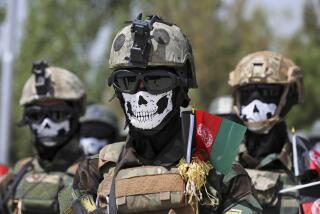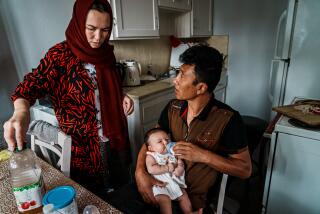Back at Base, U.S. Troops Say Afghans Failed Them
- Share via
BAGRAM AIR BASE, Afghanistan — Weary and sunburned but proud, 400 American soldiers who fought tenacious battles with Al Qaeda and Taliban troops in eastern Afghanistan returned here Sunday, some of them telling bitter stories of being let down by an Afghan commander.
The troops represent about a third of the U.S. force sent to battle Taliban and Al Qaeda holdouts in the mountainous Shahi Kot region in a campaign dubbed Operation Anaconda. But senior Bush administration officials gave conflicting accounts Sunday of whether the pullout meant the battle was winding down.
Maj. Bryan Hilferty, a spokesman for the Army’s 10th Mountain Division here, told reporters, “The major fighting of the battle is over.”
But Army Gen. Tommy Franks, commander of U.S. forces in Afghanistan, disputed the notion that the fight in rugged terrain south of Gardez, which began March 2, was subsiding. He said that it was evolving and that troops were being repositioned within the battlefield or on its perimeter. In some cases, he said, fresh troops were rotating in.
“I’m satisfied with our progress up to this point,” Franks said on ABC’s “This Week.” “And we’ll continue to work our way through this area until we are satisfied that we have taken out all” of the enemy forces.
He added that the U.S. forces had found no sign of either Osama bin Laden or other Al Qaeda leaders.
Air Force Gen. Richard Myers, chairman of the Joint Chiefs of Staff, said on CNN’s “Late Edition With Wolf Blitzer” that the soldiers who returned to Bagram would “rearm and refit” and return to the battlefield. Secretary of State Colin L. Powell said on CBS’ “Face the Nation” that troops were “mopping up.”
In Gardez, the capital of Paktia province, about 25 miles north of the fighting, U.S. bombers and helicopters could be seen flying Sunday, and the heavy concussion of bombs targeting enemy positions could be heard as night fell.
Safi Ullah, a spokesman for the city’s council, said Sunday night that local Afghan forces were still getting ready to join the United States in a few days in a renewed ground assault against the Al Qaeda and Taliban fighters who have taken shelter in an extensive cave complex.
But there were also growing signs of tension in Gardez over the presence of 1,000 troops from the north, under the command of Gen. Gul Hydar, who had arrived Saturday after having been sent from Kabul by the central government.
Among the soldiers returning to the base in Bagram, there was pride at what U.S. and allied forces had accomplished since the first day of the battle, when the operation, named for a snake that encircles and then constricts its prey, was surprised by the enemy.
Hilferty said U.S.-led coalition troops were in control of the Shahi Kot valley, which was taken during the only concerted ground warfare by U.S. troops. That fighting cost the lives of eight Americans and left at least 13 wounded.
“If I was an Al Qaeda guy, I would not go out for a pizza,” Hilferty said. Still, he said, pockets of resistance remained.
The troops had gone into battle with a mission to form “blocking positions” in the valley, a military term for preventing the enemy’s escape. Theirs was an opening move in Anaconda, an operation encompassing an area of 60 to 70 square miles.
Allied Afghan troops, commanded by Gen. Zia Lodin, were supposed to have led their forces, including tanks, into the southern end of the narrow Shahi Kot valley to flush Al Qaeda and Taliban fighters from their strongholds toward the U.S. forces, but the Afghans came under fire and never made it to their position, the soldiers said.
Hilferty and the other soldiers interviewed in Bagram said Lodin’s failure to arrive with his forces left U.S. troops the targets of withering mortar and gunfire from the south, where Lodin should have been.
Several returning soldiers heaped derision on Lodin and painted a picture of a well-prepared opposition that made ample use of advanced weaponry.
“He punked out on us,” said a sergeant from the 10th Mountain Division, based in Fort Drum, N.Y., who identified himself only as Shawn. “I don’t know how much we paid him, but I’ll shoot him myself. He was supposed to roll in. Day 1 he was supposed to attack, and we were supposed to set up blocking positions so they couldn’t get out.”
Another member of the 10th Mountain Division, who identified himself as Shannon, said Lodin “didn’t perform. He took a couple of mortar rounds and took off.”
But a Special Forces officer, who identified himself only at Lt. Col. Mark, defended Lodin’s role, saying he had an “insufficient force ratio” but recovered from a serious mortar attack to take several key positions on the second day of battle and again, about four days later. Lodin now is helping block key roads, he added.
Afghans No Less Brave
“The forces [Afghans] put together are different from our American military force. They’re not an American military force. We can’t expect them to be,” he said. “It makes them no less noble, no less brave, no less willing to get out and engage our common enemy, and Gen. Zia has, make no mistake about it. I take exception to those folks who complain about what these people have done to get us to this point in the battlefield. You wear his shoes that he has worn for five months in this battlefield.”
The lieutenant colonel estimated remaining Al Qaeda forces at “between 100 to 200 left in the valley.” He added that “we are not approaching the most dangerous part [of the war]. We’re in it.”
In two villages that had been held by Al Qaeda forces, U.S. troops found night-vision goggles identical to the ones used by U.S. troops, Shawn said.
“They’re a helluva lot more fancy than people give them credit for,” he said. “There were lots of weapons, mortar tubes. These guys were good with mortars.”
In the first days of the battle, mortars rained down from elevations of about 9,500 feet, about 1,000 feet above U.S. troops, and appeared to be carefully aimed, also suggesting that Al Qaeda forces were well prepared for the offensive.
The 187th Infantry Regiment, part of the 101st Airborne Division, was forced into a “hasty defense” position from its original task of blocking the northern end of the valley, according to Lt. Shane Owens, 25, a platoon leader from Antwerp, Ohio.
The 187th, based at Ft. Campbell, Ky., had two battalions in the field.
“They were definitely good shooters,” Jacob Lopez, a 21-year-old specialist, said of the Al Qaeda fighters. Lopez said he is with Charlie Company of the 1st Battalion of the 187th Infantry Regiment.
“They knew how to send in the mortar rounds,” Lopez said. “They can bracket their rounds real quick.”
First Lt. Charles Thompson, of the 10th Mountain Division, said his troops had secured a small Al Qaeda compound before a platoon-sized force attacked them from the south--the direction from which Lodin was supposed to have been moving.
Thompson’s men repelled the assault with mortar fire, and airstrikes apparently inflicted heavy casualties on the attackers. After that, a much-reduced Al Qaeda force came up the valley “in twos or threes,” or fired sniper shots, but never mounted a serious threat to U.S. troops positioned on ridges on the eastern and western sides of the valley.
“They kind of hit us by surprise at first, south of the compound, and moved up,” Thompson said. “But aircraft blew up about a platoon-sized element.”
Ethnic Tensions Mount
In Gardez, the tensions among the Afghan troops working with U.S. forces and local Afghans continued to simmer Sunday.
Hydar’s troops are largely ethnic Tajiks from the far north of Afghanistan, and some ethnic Pushtuns in Gardez see their presence as a sign that Tajiks will try to take revenge on Pushtuns for the excesses committed by the Pushtun-dominated Taliban.
On Sunday, a local Pushtun commander, Mohammed Ismail, told reporters that Hydar’s troops should go back to Kabul, the capital, because Paktia’s local forces could take care of Al Qaeda on their own.
Speaking to reporters earlier, both Hydar and council spokesman Safi Ullah were dismissive of such concerns, saying that both forces were on the same side and had the same goal: to eliminate terrorism from Afghanistan.
And Lt. Col. Mark said that the vast majority of new forces were Pushtun and that commanders had dropped rivalries for the larger goal of eliminating the last of the Taliban and Al Qaeda pockets.
Hydar received a delegation of chieftains from the town of Zormat on Sunday who asked him to pursue a peaceful surrender of the Taliban fighters in the mountains before launching any attacks. The meeting was significant because Zormat is the hometown of the commander believed to be leading the Taliban and Al Qaeda forces, Mullah Saifur Rahman Mansour, and the town is considered sympathetic to them.
But U.S. forces have been leery of protracted surrender negotiations because, in the past, the time has been used by Al Qaeda fighters to slip away from coalition forces.
*
Mohan reported from Bagram and Schrader from Washington. Times staff writers John Daniszewski in Kabul and Jube Shiver Jr. in Washington contributed to this report.
*
RELATED STORY
Memorial for reporter: Friends, family remember Daniel Pearl xxxxx xxxx xx xxxxx x xxxx. B1
More to Read
Sign up for Essential California
The most important California stories and recommendations in your inbox every morning.
You may occasionally receive promotional content from the Los Angeles Times.














